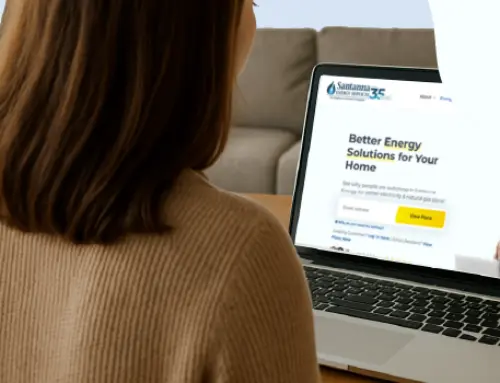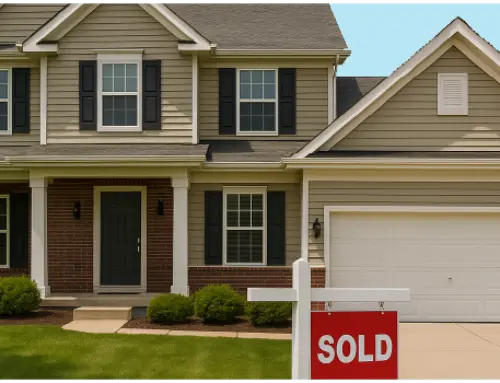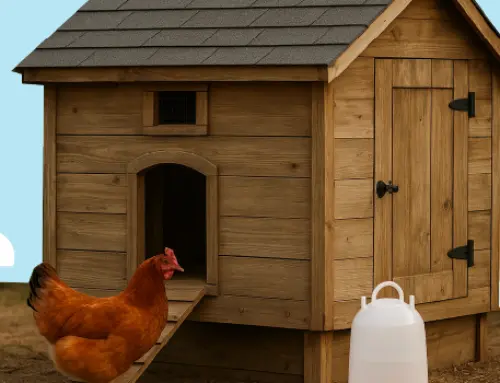How to Increase Water Pressure in Your Home
by Tyler Castle
19.1 min read
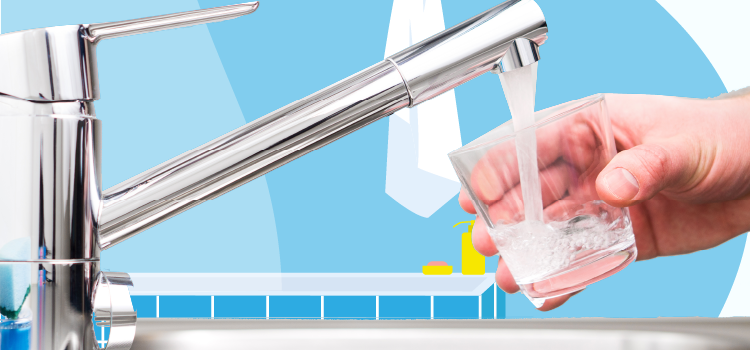
Water pressure plays a pivotal role in the functionality and comfort of a home’s plumbing system. Whether you’re taking a shower, doing laundry, washing dishes, or running a sprinkler system, the right pressure ensures that water flows efficiently and reliably.
In most households, water pressure is something we take for granted—until it drops. Sudden or persistent low water pressure can affect everything from how long it takes to fill a bathtub to how well your dishwasher cleans. It can even cause some appliances, like tankless water heaters or washing machines, to shut off or underperform due to insufficient pressure and even leads to higher utility bills.
If water pressure scares you, no need to worry; our guide breaks down everything you need to know about home water pressure and how you can increase it. Let’s dive in!
What Is the Normal Water Pressure in a Home?
Normal water pressure can make or break the functionality of a home. Residential water pressure is typically measured in pounds per square inch (psi). As a rule of thumb, normal water pressure should fall within a range of 50 to 70 psi.
Water pressure falling below or even above this level can spell disaster for your home. Water pressure exceeding 80 psi is considered too high and may lead to plumbing issues, water damage and wear and tear on your pipes. While too low water pressure can lead to slower water and high, unnecessary water consumption.
If you’re unsure where your home stands, using a simple water pressure gauge to test can help you catch and address potential issues early—before they turn into costly repairs.
What Does Poor Water Pressure in a Home Mean?
Poor water pressure in a home manifest as a weak or inconsistent flow of water from fixtures. This can result in longer times to fill pots, inadequate shower experiences, and appliances that take longer to operate.
When you turn on a faucet and the water pressure feels lower than expected, it generally means one of three things: there’s not enough water entering your plumbing system, there’s a blockage somewhere restricting flow, or a leak is causing pressure loss within the system.
While issues like blockage and leaks can be solved with a quick DIY fix, controlling your water pressure can be a lot more complicated. If the water pressure in your home drops toward the lower (or poorer) end of that range—especially near or below 30 PSI—you may start to notice several frustrating and potentially costly issues, including:
- Reduced functionality resulting in Weak showers and slow-filling tubs or sinks as well as appliances like dishwashers, washing machines, and tankless water heaters may underperform or fail to operate correctly due to insufficient pressure.
- Household inconvenience where you may be unable to run multiple fixtures at the same time. Low water pressure also means large systems like lawn irrigation systems may fail to cover their zones effectively.
- Poor water pressure in a home can act as a warning of bigger problems like a partially closed main valve, a leak in your plumbing system, a malfunctioning pressure regulator, and corroded or clogged pipes leading to timely and costly repairs.
Why Is My Water Pressure Low?
If you’re consistently experiencing low water pressure in your home, there are many culprits that could be causing this issue. Understanding the root causes of low water pressure can help you troubleshoot effectively and decide whether it’s a quick fix or something that needs professional attention. Here are the most frequent causes of low water pressure:
1. Clogged or Corroded Pipes
Over time, pipes—especially in older homes—can develop internal blockages due to mineral buildup, limescale, rust, or other debris. This reduces the internal diameter of the pipe, restricting flow and causing pressure to drop. Galvanized steel pipes are particularly prone to this issue and may eventually require replacement.
2. Leaking Pipes
Leaks—whether visible or hidden underground or behind walls—allow water to escape before it reaches your fixtures. Even small leaks can cause a noticeable drop in pressure and increase your water bill. Common signs include damp spots, mold growth, or the sound of running water when everything is turned off.
3. Chemical Build Up
If you’re wondering, why is my water pressure low, sometimes, the issue is localized. A clogged showerhead or faucet aerator can restrict water flow due to sediment or calcium buildup. Replacing or cleaning these fixtures can restore normal pressure in specific areas of the home but leaving these chemicals to build up over time can not only affect your water pressure but your whole plumbing system too.
4. Closed or Partially Closed Valves
If the main water shutoff valve (typically inside your home) or the water meter valve (usually outside) isn’t fully open, it can significantly reduce water pressure throughout your home. While some people may intentionally partially close a valve to reduce pressure, slow a minor leak, or manage water use during a drought or cold weather, this is usually a temporary solution and not ideal for long-term water flow.
If you’re experiencing widespread pressure issues and haven’t made any intentional adjustments, always verify that both valves are fully open to ensure proper water pressure.
5. Malfunctioning Pressure Regulator
Some homes have a pressure-reducing valve (PRV) that ensures incoming water pressure stays within a safe range. If this regulator fails or is set incorrectly, you may experience pressure that’s too low—or even dangerously high. A malfunctioning PRV should be inspected and replaced by a professional plumber.
6. Water Meter Problems
If the meter or its fittings have been recently repaired, replaced, or disturbed (e.g., during nearby construction or utility work), it’s worth checking for obstructions, debris buildup, or partially closed valves near the meter. Sometimes, the meter valve may not be fully reopened after maintenance, leading to restricted flow.
7. High Household Demand
Wondering, why is my water pressure low, can come down to the appliances in your home. If multiple water-using appliances or fixtures are running at once—like the washing machine, shower, and dishwasher—your system may not be able to deliver sufficient pressure everywhere. The more people in your home using appliances at once, can lower your water pressure too. This issue can be more noticeable in homes with older plumbing or inadequate pipe sizing.
8. Shared or Undersized Supply Lines
In neighborhoods where multiple homes share a main water line, heavy usage by nearby homes—especially during peak times—can lead to temporary drops in pressure. Similarly, if your home’s plumbing system uses undersized pipes, it may struggle to deliver water at adequate pressure during high-demand moments.
9. Municipal Water Supply Issues
Sometimes the issue with low water pressure can be found beyond your property line. Your local water provider may be performing maintenance, repairing a main line break, or dealing with fluctuating demand on a day you’re experiencing lower than usual water pressure.
Additionally, newly enforced water conservation regulations can sometimes result in lowered pressure limits. Be sure to keep well informed of your utilities maintenance schedule so you don’t mistake this minor inconvenience as a real problem.
10 Distance from Water Source or Elevation
Lastly, homes located far from the municipal supply line or situated at a higher elevation than the source may naturally experience lower pressure due to gravitational resistance and friction loss along long pipe runs. In such cases, installing a booster pump may be necessary.
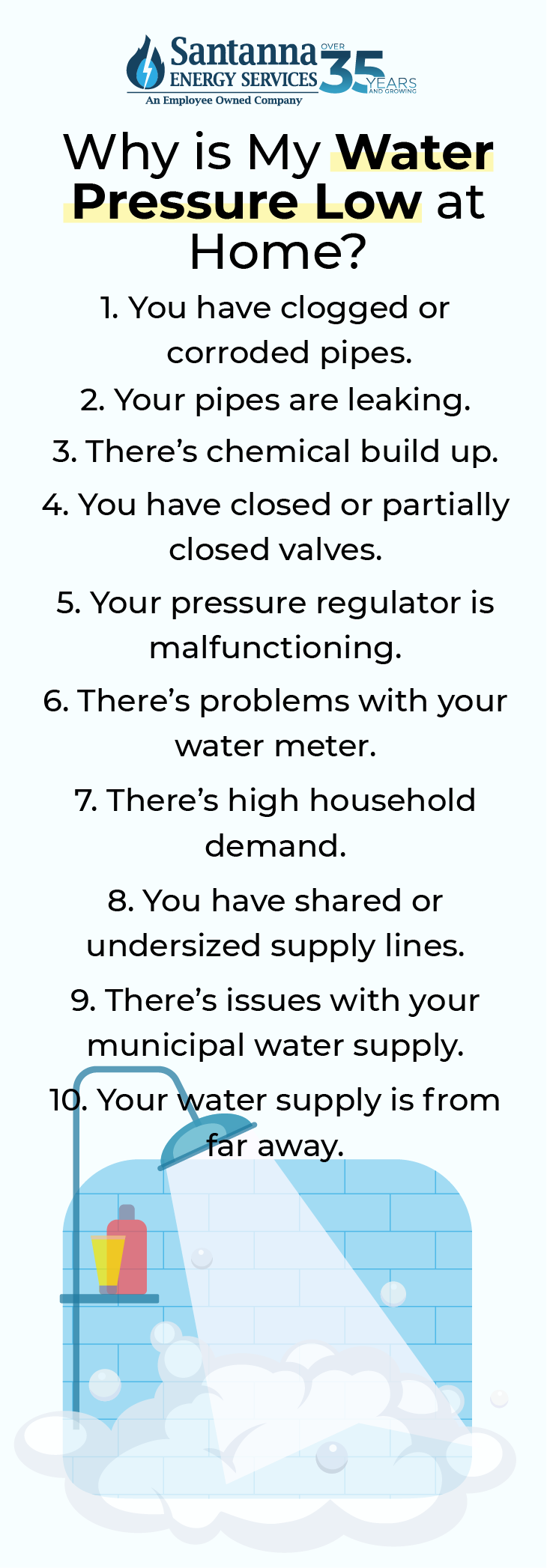
How to Check Water Pressure in Your Home
Experiencing lower than usual water pressure? Luckily there are ways to check your water pressure levels simply without the need for a professional plumber. Here’s an easy way to check the water pressure in your home with a DIY solution using a pressure gauge:
1. Choose Your Location
First, start by choosing your location and be sure to pick a faucet to test that connects directly to your home’s main water line for the most accurate reading. The best outlet is typically an outdoor hose bib or the cold-water supply faucet near your water heater. Avoid using faucets inside the home that are downstream of pressure-reducing valves or filters, as these may skew the results.
2. Turn Off Running Water
Before testing, make sure all faucets, showers, dishwashers, washing machines, and sprinklers are completely turned off. This ensures that the pressure reading isn’t artificially lowered by water usage elsewhere in the home, giving you a true baseline measurement.
3. Install the Pressure Gauge
Next, screw a home water pressure gauge tightly onto the faucet. These gauges are inexpensive and available at most hardware stores. Make sure the connection is snug and leak-free—if needed, use plumber’s tape on the threads for a better seal. A good gauge will have a dial clearly marked with PSI (pounds per square inch).
4. Start the Pressure Test
Turn on the faucet to which the gauge is attached. Within seconds, the needle will stabilize and give you a reading. 50–70 PSI is typical and acceptable for most homes while any reading below 30 PSI suggests low pressure that may need attention. Anything above 80 PSI is considered too high and could damage your plumbing system—this might indicate a faulty pressure regulator.
How to Increase Water Pressure in Your Home
Low water pressure doesn’t always require a major overhaul—sometimes, a few simple checks or adjustments can make a noticeable difference. Here’s how to increase water pressure in your home:
1. Inspect and Open Valves
Start by checking both your main shut-off valve (typically located where the water line enters your home) and your water meter valve (often found near the street or property line). If either is partially closed—even slightly—it can choke the water supply, resulting in reduced pressure. These valves should be fully open to allow optimal flow. This is often the easiest and quickest fix and is commonly overlooked, especially after recent plumbing work or emergency shut-offs.
2. Clean Your Water Fixtures
Mineral deposits, especially in areas with hard water, can clog faucet aerators and showerheads, restricting flow at the fixture level. The cleaning process can vary based on the type of chemical build up but typically you can clean your fixture by first removing the aerator or showerhead and soaking your fixture in vinegar for a few hours to dissolve limescale and other caked on chemicals.
For other stubborn chemicals, scrub your fixture gently with a toothbrush to remove stuck on chemicals and blockage. After this is done, rinse your fixture and reinstall. Doing this periodically can keep water flowing smoothly and help maintain consistent pressure in specific locations around the home.
3. Check for Leaks
When water escapes through hidden leaks—whether behind walls, under floors, or even underground—it reduces the amount of water reaching your faucets, showers, and appliances. Even small, undetected leaks can gradually impact overall pressure and increase your water bills.
To check for hidden leaks, follow this simple method:
- Turn off all water fixtures and appliances in your home, including faucets, dishwashers, washing machines, and sprinklers.
- Locate your water meter (typically outside near the curb or in a basement utility area) and note the current reading.
- Wait at least 1–2 hours without using any water.
- Check the meter reading again. If the numbers have changed, water is still flowing—indicating a possible leak.
This test can help you determine whether a leak exists, even if there are no visible signs. Keep in mind that leaks can occur in hard-to-see places, such as slab foundations, crawl spaces, or behind drywall.
If you suspect a hidden leak and can’t identify the source, it’s best to call a licensed plumber. Early detection can prevent water damage and help restore your home’s water pressure.
4. Check for Clogs
Wondering how to increase the water pressure at home? Clogs can form not just in drains, but in water supply lines that can lead to decreases in home water pressure. Sediment, debris, rust, or even small pieces of disintegrating rubber from old washers can build up in elbows, T-joints, and valves, reducing water flow at specific points in the system.
If water pressure is low at a single fixture, remove and inspect the supply line and shut-off valve for blockages. For whole-home issues, a plumber may use camera inspection tools or pressure testing to locate the source of obstruction.
5. Test the Pressure Regulator Then Replace or Adjust if Necessary
Homes equipped with a pressure-reducing valve (PRV) may experience pressure problems if the regulator is malfunctioning or mis-calibrated. The PRV is typically found near where the main water line enters the house. If your water pressure is unusually high or low throughout the home, and other issues have been ruled out, a failing PRV could be the cause. Replacing or adjusting this component should be handled by a licensed plumber to avoid pressure spikes that could damage pipes and appliances.
6. Flush Your Water Heater
Sediment buildup inside your water heater’s tank—especially in areas with hard water—can restrict flow and reduce the pressure of your hot water. This can be particularly noticeable in showers or when using appliances that depend on a strong hot water supply.
Flushing the water heater annually helps maintain both temperature and pressure. Simply connect a garden hose to the drain valve, shut off the power or gas, and release the water until it runs clear. For tankless water heaters, a descaling flush may be needed to remove mineral buildup in the internal heat exchanger.
7. Replace Outdated Fixtures
Sometimes, the issue isn’t with your water supply—it’s your fixtures. Old or worn-out faucets, showerheads, and valves can become inefficient over time due to internal wear, corrosion, or mineral buildup that restricts water flow.
Replacing them with modern, high-efficiency models can immediately improve both flow and pressure. Look for WaterSense-labeled fixtures, which are designed to maintain strong flow while conserving water. These are engineered to maximize performance, even in homes with moderate pressure levels.
8. Clean or Replace Corroded Plumbing
In homes with galvanized steel or cast-iron pipes, internal corrosion is a major contributor to chronic low water pressure. Over the years, rust and mineral scale build up inside the pipe walls, narrowing the path for water and causing friction that reduces pressure.
In severe cases, re-piping the home with modern materials like PEX, CPVC, or copper may be necessary. While it’s an investment, re-piping improves water quality, restores pressure, and eliminates the risk of pipe bursts or leaks from corroded metal.
9. Increase Pipe Diameter
The diameter of your plumbing pipes directly affects how much water can flow through them at once. Smaller pipes (like ½ inch) naturally restrict flow and are more prone to pressure loss, especially in larger or multi-story homes. Upgrading to ¾ inch or even 1-inch pipes for main supply lines can improve water volume and reduce pressure drop when multiple fixtures are in use.
This is especially important when renovating a bathroom or kitchen, installing a new irrigation system, or adding a second story to your home. Consult a licensed plumber to assess which sections of your plumbing would benefit most from upsizing.
10. Consider a Water Softener
A simply way to increase the water pressure in your home is by installing a water softener. In areas with hard water, mineral deposits (like calcium and magnesium) can accumulate inside pipes, fixtures, and appliances, causing gradual flow restriction and reducing pressure. Installing a water softener can help prevent this buildup and extend the life of your plumbing system.
Water softeners not only improve pressure over time but also protect your water heater, reduce soap scum, and improve overall water quality. They’re especially useful if you notice white residue on faucets or a chalky film in sinks and tubs.
11. Install a Water Pressure Booster Pump
If your water pressure remains consistently low—even after checking valves, cleaning fixtures, and ruling out leaks—the issue may be tied to your home’s location or its distance from the municipal supply. Homes on higher elevations or at the end of a water main line often experience naturally low incoming pressure.
In such cases, installing a water pressure booster pump can provide a reliable and long-term solution on how to increase the water pressure in your home. A booster pump increases the pressure of water as it enters your home by using an electric motor and a pressure tank to amplify flow before it reaches your fixtures. These systems are often paired with a pressure switch to maintain a consistent PSI.
12. Consult Your Water Supplier
If you’ve ruled out in-home causes and your neighbors are experiencing similar issues, the problem may lie with your municipal water supply. Contact your local water provider to ask if there’s ongoing maintenance or repairs, whether there’s been a temporary or permanent reduction in supply, or if any new water conservation policies or regulations have been implemented. When it comes to your water supplier, most of these problems are temporary. Utility companies can sometimes offer pressure readings or dispatch a technician to investigate supply-side issues if lower than usual water pressure is still occurring.
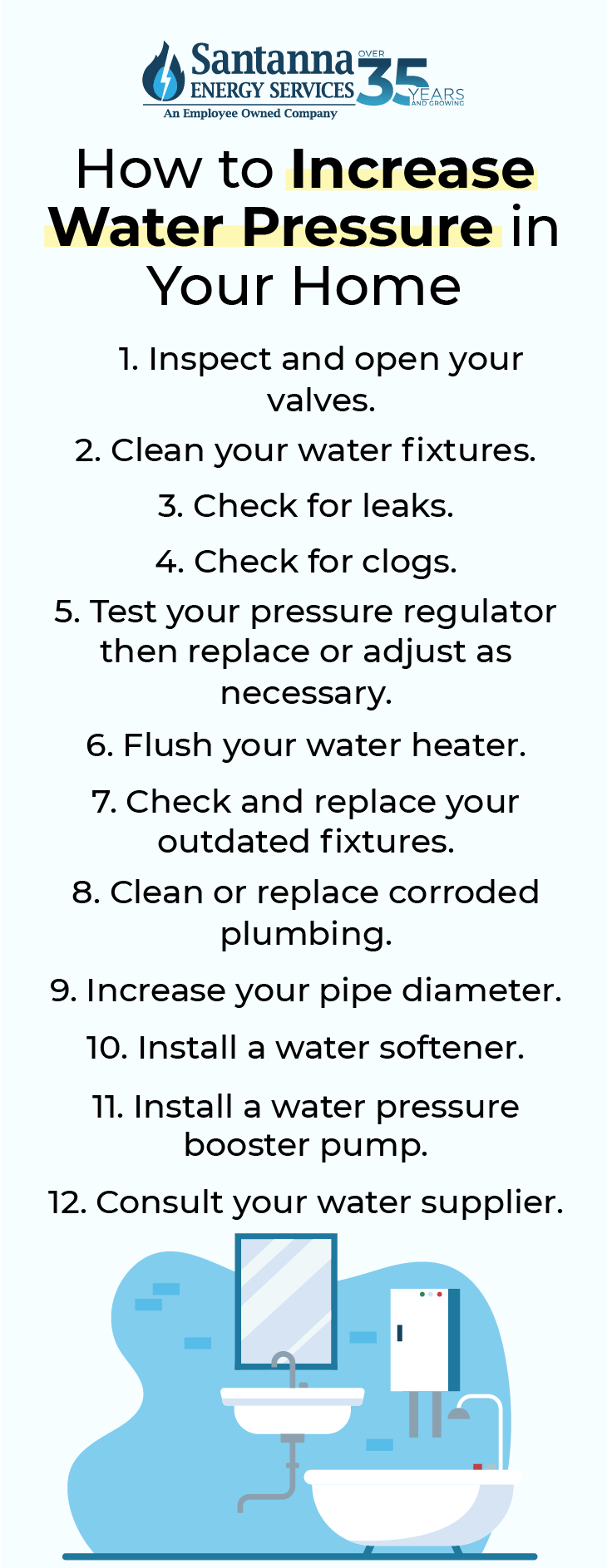
Can Old Pipes Affect Water Pressure?
Yes—old pipes are one of the most common and often overlooked culprits behind declining water pressure in homes, especially those built several decades ago. Over time, aging pipes can experience a range of issues that directly impact how efficiently water flows through your plumbing system.
Older homes often have galvanized steel or cast iron pipes, which are highly prone to internal corrosion which can lead to a significant decrease in water pressure. As these pipes age, rust and scale accumulate along the inner walls, gradually narrowing the pipe diameter.
In the same way, as pipes deteriorate, they become more vulnerable to cracks, pinhole leaks, and joint failures. Even small leaks can divert pressure and create low flow throughout the house, especially if they’re hidden inside walls or under floors.
Outdated materials like polybutylene, lead, or galvanized steel do not perform as efficiently as modern alternatives like PEX or copper piping. Besides pressure issues, older piping materials may also pose health risks or fail to meet current building codes, making replacement an even more compelling option.
Water Pressure and Pipe Maintenance Tips
Increasing the water pressure in your home is easier than you think but maintaining a normal water pressure is where things can get challenging. Here’s some of our best tips on how to maintain your plumbing system and keeping your water pressure consistent year-round:
- Consistently Check for Leaks: Even small, hidden leaks can siphon off water, lowering pressure and increasing your water bill. Regularly inspect for wet spots on walls, ceilings, or floors, and use your water meter to detect leaks when no water is in use.
- Check Your Valves Regularly: Ensure that both your main shutoff valve and water meter valve are fully open. Over time, valves can get partially closed due to maintenance or accidental bumps, restricting flow into your home.
- Check the Pressure Regulator Energy Few Years: If your home has a pressure-reducing valve (PRV), have it checked every few years. These regulators can wear out or drift out of calibration, affecting water pressure throughout the home.
- Flush Your Pipes Every Season: Sediment buildup can occur in supply lines, especially in homes with older plumbing. Flushing your system by running all taps simultaneously for a few minutes every few months can help dislodge minor blockages.
- Install a Booster Pump: For homes at higher elevations or far from the city supply, a pressure booster pump can help maintain consistent pressure. These should be installed professionally and require occasional servicing.
- Fix Leaky Pipes Immediately: Leaking pipes don’t just waste water—they reduce available pressure and can lead to significant damage if left unaddressed. Prioritize repair once leaks are discovered.
- Maintain Your Water Heater: A failing or sediment-clogged water heater can limit hot water pressure. Flush your water heater annually to remove buildup and extend its lifespan.
- Consistently Monitor Your Water Pressure: Use a water pressure gauge every 6–12 months to ensure your pressure stays within the ideal 50–70 psi range. Catching abnormal readings early can prevent costly problems.
When to Call a Professional
While some water pressure issues can be resolved through DIY methods, certain situations warrant professional intervention. When things get out of hand and too tough to handle alone, don’t hesitate when it comes to calling a professional. Here are some of the most common situations that warrant professional help when dealing with how to increase water pressure in your home:
- Persistent Low Pressure: If basic troubleshooting doesn’t resolve the issue, a licensed plumber can conduct a comprehensive assessment. Sometimes low water pressure can lead to a deeper issue with pipes that DIY methods just can’t fix.
- Major Leaks: Significant leaks or those within walls and foundations require professional repair to prevent structural damage. When duct tape won’t stop leaking, it’s time for the professionals to step in. Waiting too long can lead to water damage and costly repairs, which plumbing professionals can help reduce.
- Pressure Regulator Replacement: Replacing or repairing a faulty pressure regulator is best handled by professionals to ensure system integrity.
- Pipe Corrosion or Blockages: Identifying and replacing corroded or blocked pipes necessitates specialized knowledge and tools. Piping in a home is an intricate and delicate system. One wrong move can lead to major leaks and problems with faucets throughout your home.
FAQs
Why is my water pressure low in only one fixture?
Localized low pressure is typically caused by a clogged aerator or showerhead, especially in areas with hard water. Debris or mineral buildup can obstruct the flow. Simply unscrewing the fixture and soaking it in vinegar for a few hours can often resolve the issue. If the problem persists, the pipe leading to the fixture might be partially blocked or damaged.
Is low water pressure a sign of a leak?
Absolutely. A sudden or unexplained drop in water pressure can be a major red flag for a leak—especially underground or behind walls. You can verify this by turning off all water inside the house and checking the water meter. If it continues moving, a hidden leak is likely present. Addressing this quickly is critical to prevent structural damage and mold growth.
Low water pressure may seem like a minor inconvenience, but it often signals underlying issues that deserve attention—from valve positions and clogs to aging pipes and city supply inconsistencies. The good news? Most water pressure issues can be diagnosed and solved with a little know-how—or professional help when needed.
If you’ve done everything you can and the pressure still isn’t right, don’t hesitate to bring in a licensed plumber. Your water pressure isn’t just about convenience—it’s about maintaining the integrity and functionality of your home’s plumbing system.
Tyler is an experienced energy professional, having worked for Santanna Energy Services, for the past four years. He is passionate about renewable energy and believes that diversifying the energy grid is the key to a sustainable future. Tyler is dedicated to supplying consumers with the best possible energy solutions and works diligently to make sure that Santanna can deliver the highest quality service.



